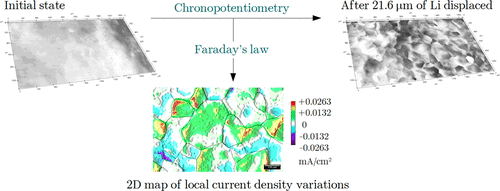当前位置:
X-MOL 学术
›
ACS Appl. Mater. Interfaces
›
论文详情
Our official English website, www.x-mol.net, welcomes your
feedback! (Note: you will need to create a separate account there.)
Quantification of the Local Topological Variations of Stripped and Plated Lithium Metal by X-ray Tomography.
ACS Applied Materials & Interfaces ( IF 8.3 ) Pub Date : 2020-08-17 , DOI: 10.1021/acsami.0c10860 Lucile Magnier 1, 2 , Didier Devaux 2 , Joël Lachambre 1 , Margaud Lecuyer 3 , Marc Deschamps 3 , Renaud Bouchet 2 , Eric Maire 1
ACS Applied Materials & Interfaces ( IF 8.3 ) Pub Date : 2020-08-17 , DOI: 10.1021/acsami.0c10860 Lucile Magnier 1, 2 , Didier Devaux 2 , Joël Lachambre 1 , Margaud Lecuyer 3 , Marc Deschamps 3 , Renaud Bouchet 2 , Eric Maire 1
Affiliation

|
Lithium (Li) metal is the most promising negative electrode to be implemented in batteries for stationary and electric vehicle applications. For years, its use and subsequent industrialization were hampered because of the inhomogeneous Li+ ion reduction upon recharge onto Li metal leading to dendrite growth. The use of solid polymer electrolyte is a solution to mitigate dendrite growth. Li reduction leads typically to dense Li deposits, but the Li stripping and plating process remain nonuniform with local current heterogeneities. A precise characterization of the behavior of these heterogeneities during cycling is then essential to move toward an optimized negative electrode. In this work, we have developed a characterization method based on X-ray tomography applied to model Li symmetric cells to quantify and spatially probe the Li stripping/plating processes. Ante- and post-mortem cells are recut in smaller cells to allow a 1 μm voxel size resolution in a conventional laboratory scanner. The reconstructed cell volume is postprocessed to numerically reflatten the Li electrodes, allowing us a subsequent precise measurement of the electrode and electrolyte thicknesses and revealing local interface modifications. This in-depth analysis brings information about the location of heterogeneities and their impact on the electrode microstructure at both the electrode grains and grain boundaries. We show that the plating process (reduction) induces more pronounced heterogeneities compared to the stripping (oxidation) one. The existence of crosstalking between the electrodes is also highlighted. In addition, this simple methodology permits to finely retrieve and then surface map the local current density at both electrodes based on the local thickness change during the redox process.
中文翻译:

X射线断层摄影术对剥离和镀覆的锂金属局部拓扑变化的量化。
金属锂(Li)是最有前途的负极,可用于固定式和电动汽车应用的电池中。多年来,由于Li +的不均一性,阻碍了其使用和随后的工业化再充电到锂金属上时离子还原,导致枝晶生长。固体聚合物电解质的使用是减轻枝晶生长的解决方案。锂还原通常会导致致密的锂沉积,但是由于局部电流异质,锂的剥离和镀覆过程仍然不均匀。因此,对于循环过程中这些异质性行为的精确表征对于朝着优化的负极移动至关重要。在这项工作中,我们已经开发了一种基于X射线断层扫描的表征方法,该方法适用于对Li对称细胞进行建模以量化和空间探测Li剥离/镀覆过程。将死前和死后细胞重新切成较小的单元,以在常规实验室扫描仪中允许1μm的体素大小分辨率。重建后的电池体积将进行后处理,以在数值上重新填充锂电极,使我们能够随后精确测量电极和电解质的厚度,并揭示出局部界面的变化。这种深入的分析带来了有关异质性位置及其对电极晶粒和晶界处电极微结构的影响的信息。我们表明,与汽提(氧化)相比,电镀过程(还原)引起更明显的异质性。电极之间的串扰也存在。另外,这种简单的方法允许根据氧化还原过程中局部厚度的变化,精确地获取然后在两个电极上对局部电流密度进行表面映射。这种深入的分析带来了有关异质性位置及其对电极晶粒和晶界处电极微结构的影响的信息。我们表明,与汽提(氧化)相比,电镀过程(还原)引起更明显的异质性。电极之间的串扰也存在。另外,这种简单的方法允许根据氧化还原过程中局部厚度的变化,精确地获取然后在两个电极上对局部电流密度进行表面映射。这种深入的分析带来了有关异质性位置及其对电极晶粒和晶界处电极微结构的影响的信息。我们表明,与汽提(氧化)相比,电镀过程(还原)引起更明显的异质性。电极之间的串扰也存在。另外,这种简单的方法允许根据氧化还原过程中局部厚度的变化,精确地获取然后在两个电极上对局部电流密度进行表面映射。我们表明,与汽提(氧化)相比,电镀过程(还原)引起更明显的异质性。电极之间的串扰也存在。另外,这种简单的方法允许根据氧化还原过程中局部厚度的变化,精确地获取然后在两个电极上对局部电流密度进行表面映射。我们表明,与汽提(氧化)相比,电镀过程(还原)引起更明显的异质性。电极之间的串扰也存在。另外,这种简单的方法允许根据氧化还原过程中局部厚度的变化,精确地获取然后在两个电极上对局部电流密度进行表面映射。
更新日期:2020-09-16
中文翻译:

X射线断层摄影术对剥离和镀覆的锂金属局部拓扑变化的量化。
金属锂(Li)是最有前途的负极,可用于固定式和电动汽车应用的电池中。多年来,由于Li +的不均一性,阻碍了其使用和随后的工业化再充电到锂金属上时离子还原,导致枝晶生长。固体聚合物电解质的使用是减轻枝晶生长的解决方案。锂还原通常会导致致密的锂沉积,但是由于局部电流异质,锂的剥离和镀覆过程仍然不均匀。因此,对于循环过程中这些异质性行为的精确表征对于朝着优化的负极移动至关重要。在这项工作中,我们已经开发了一种基于X射线断层扫描的表征方法,该方法适用于对Li对称细胞进行建模以量化和空间探测Li剥离/镀覆过程。将死前和死后细胞重新切成较小的单元,以在常规实验室扫描仪中允许1μm的体素大小分辨率。重建后的电池体积将进行后处理,以在数值上重新填充锂电极,使我们能够随后精确测量电极和电解质的厚度,并揭示出局部界面的变化。这种深入的分析带来了有关异质性位置及其对电极晶粒和晶界处电极微结构的影响的信息。我们表明,与汽提(氧化)相比,电镀过程(还原)引起更明显的异质性。电极之间的串扰也存在。另外,这种简单的方法允许根据氧化还原过程中局部厚度的变化,精确地获取然后在两个电极上对局部电流密度进行表面映射。这种深入的分析带来了有关异质性位置及其对电极晶粒和晶界处电极微结构的影响的信息。我们表明,与汽提(氧化)相比,电镀过程(还原)引起更明显的异质性。电极之间的串扰也存在。另外,这种简单的方法允许根据氧化还原过程中局部厚度的变化,精确地获取然后在两个电极上对局部电流密度进行表面映射。这种深入的分析带来了有关异质性位置及其对电极晶粒和晶界处电极微结构的影响的信息。我们表明,与汽提(氧化)相比,电镀过程(还原)引起更明显的异质性。电极之间的串扰也存在。另外,这种简单的方法允许根据氧化还原过程中局部厚度的变化,精确地获取然后在两个电极上对局部电流密度进行表面映射。我们表明,与汽提(氧化)相比,电镀过程(还原)引起更明显的异质性。电极之间的串扰也存在。另外,这种简单的方法允许根据氧化还原过程中局部厚度的变化,精确地获取然后在两个电极上对局部电流密度进行表面映射。我们表明,与汽提(氧化)相比,电镀过程(还原)引起更明显的异质性。电极之间的串扰也存在。另外,这种简单的方法允许根据氧化还原过程中局部厚度的变化,精确地获取然后在两个电极上对局部电流密度进行表面映射。


















































 京公网安备 11010802027423号
京公网安备 11010802027423号